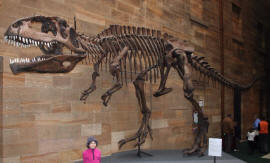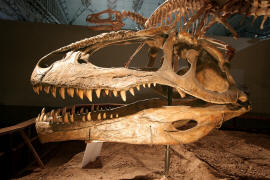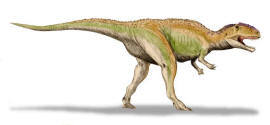been recovered. It
is only known from a portion of the left
dentary which is 8%
larger than the equivalent bone from the holotype. This largest
Giganotosaurus specimen is
estimated to represent an individual with a skull length of 195 cm (6.40
ft), compared to the holotype's estimated at 1.80 m (5.9 ft) skull, making
it likely that Giganotosaurus
had the largest skull of any known theropod.
Giganotosaurus surpassed
Tyrannosaurus in mass
by at least half a ton (the upper size estimate for
T. rex is 9.1 t).
Paleobiology
Giganotosaurus carolinii
was slightly larger than Tyrannosaurus rex,
but had a brain only about half as big as those of tyrannosaurids.
The teeth of Tyrannosaurus
were longer and wider, and more variable in size. The teeth of
Giganotosaurus were
shorter, less variable and narrower than those of
Tyrannosaurus, and were
more adapted for slicing flesh.
A well-developed
olfactory region means
that it probably had a good sense of smell. Its skull,
although large, had a slender build.
Titanosaur fossils have
been recovered near the remains of
Giganotosaurus, leading to
speculation that
these carnivores may have preyed on the giant herbivores. Fossils of
related carcharodontosaurids grouped closely together may indicate pack
hunting, a behavior that could possibly extend to
Giganotosaurus itself.
Blanco and Mazzetta (2001) estimated
that Giganotosaurus
might have been capable of running at speeds up to 14 metres per second (50
km/h; 31 mph).
Classification
Giganotosaurus, along with relatives like
Tyrannotitan,
Mapusaurus and
Carcharodontosaurus, are members of the carnosaur family
Carcharodontosauridae. Both Giganotosaurus and Mapusaurus
have been placed in their own subfamily
Giganotosaurinae by Coria and Currie in 2006 as more carcharodontosaurid
dinosaurs are found and described, allowing interrelationships to be
calculated.
In Popular Culture
The original fossils of
Giganotosaurus remain at
the
Carmen Funes Museum in
Neuquen, Argentina, but
replicas are common in other places, including the Australian Museum in
Sydney. Despite having
been discovered relatively recently,
Giganotosaurus is already gaining a name for
itself in popular culture.
Giganotosaurus
was featured in
Dino Crisis 2, but was
somewhat exaggerated in size; the game's giganotosaur was said to be over 7
metres tall and 20 meters long, when the actual creature was about 4 metres
tall and 13 meters long. It was capable of throwing an adult
Tyrannosaurus.
Giganotosaurus
appears in the
Chased by Dinosaurs
special Land of Giants.
They are seen to hunt both independently and in packs, working together to
bring down an
Argentinosaurus.
Giganotosaurus
is also featured in the IMAX movie
Dinosaurs: Giants of Patagonia
where Dr. Rodolfo Coria shows the sites of major discoveries in Argentina.
It also has a robotic animal kit,
from the popular
Zoids series, released
after the species known as
Gojulas Giga.
Giganotosaurs appear in the
Dinotopia story
The World Beneath as
unexpected protagonists in the Rainy Basin.
Giganotosaurus
also appeared in the third season of
Primeval, where it was
portrayed as being capable of running huge distances at high speeds despite
its massive size and weight. It attacks a jumbo jet and kills wildlife
expert Nigel Marven.
A female
Giganotosaurus named Laura
with an Argentinean accent is
one of the characters in
Dinosaur Train.
Return to the
Old Earth Ministries Online Dinosaur
Curriculum homepage.

Shopping
Bay
State Replicas - Giganotosaurus tooth, 1/9th scale skull
 Replica
skeleton at the
Australian Museum in
Sydney
Replica
skeleton at the
Australian Museum in
Sydney

